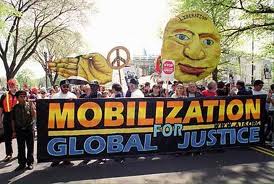I want to start part 2 of my blogs on movements by sharing the story of a global movement against the injustice of slave labor in the Congo that occurred in the latter part of the 1800’s. This is a story that very few people have heard of, and is still part of the story of what is going on in Central Africa today. To go forward we must look back. That is why studying history is so important.
Though this movement was ignited by a catalyst named Edmund Morel, he was only one of many brave souls, including a black journalist and historian named George Washington Williams and another black American named William Sheppard, who spoke out against the evil of slave labor in the Congo. Movements always start with a few catalysts and champions who are willing to sacrifice for the cause.
King Leopold II, the King of Belgium, desperately wanted to have a colony just like the British and the French. Because Belgium was not a big or powerful country, Leopold used guile and deception to colonize the Congo. Ostensibly, his motives appeared to be philanthropic. He claimed to be putting a stop to the slave trade and to be helping the people by welcoming in missionaries and investing in the infrastructure. Yet in reality, King Leopold was driven by greed and ego. He wanted to be seen as an important player in the eyes of the colonizing countries. He wanted a piece of the action in Africa, including the pillaging of Africa’s natural resources and people. It is estimated that between 5 to 8 million lives were lost through slavery in the Congo itself.
After observing the plunder of rubber and ivory coming off the ships in Antwerp, Edmund made the bold move of blowing the whistle on the egregious atrocities that King Leopold II and his minions were committing in the Congo. Below is a quote from the book King Leopold’s Ghost by Adam Hochschild, that tells the story of how this one man gave his life to start and sustain a global movement against the injustice of slave labor in Africa.
Brought face to face with evil, Morel does not turn away. Instead, what he sees determines the course of his life and the course of an extraordinary movement, the first great international human rights movement of the twentieth century. Seldom has one human being – impassioned, eloquent, blessed with brilliant organizational skills and nearly superhuman energy – managed almost single-handedly to put one subject on the world’s front pages for more than a decade. Only a few years after standing on the docks of Antwerp, Edmund Morel would be at the White House, insisting to President Theodore Roosevelt that the United States has a special responsibility to do something about the Congo. He would organize delegations to the British Foreign Office. He would mobilize everyone from Booker T. Washington to Anatole France to the Archbishop of Canterbury to join his cause. More than two hundred mass meetings to protest slave labor in the Congo would be held across the United States. A larger number of gatherings in England – nearly three hundred a year at the crusade’s peak – would draw as many as five thousand people at a time. In London, one letter of protest to the the Times on the Congo would be signed by eleven peers, nineteen bishops, seventy six members of Parliament, the presidents of seven Chambers of Commerce, thirteen editors of major newspapers, and every lord mayor in the country. Speeches about the horrors of King Leopold’s Congo would be given as far away as Australia. In Italy, two men would fight a duel over the issue. British Foreign Secretary Sir Edward Grey, a man not given to overstatement, would declare that ‘no external question for at least thirty years has moved the country so strongly and vehemently’. (p. 2)
How are Movements Sustained?
- Slow and Small precedes Speed and Size: Most movements that last start very slow and small with a very simple, yet big idea. Before the movement gains traction amongst the masses, there has been an incubation period when the cause or idea is percolating. It takes time before there is a tipping point, or before the idea snowballs, picking up speed and momentum as it spreads. If you look at the issue of the invisible children and Kony in Uganda, there have been people on the ground addressing this issue for many years. Suddenly the issue has caught the attention of the mainstream. My dad spent over 20 years in Africa modeling the practice of crop rotation and summer fallowing as a way of farming. It took years before a few Africans decided to adopt this practice, instead of the short term subsistence-living worldview which had resulted in poor crops by draining the soil of nutrients year after year. Every year, they would query my dad about why his crops were so much better than theirs, and every year he would tell them to practice crop rotation. Finally, after some years, he was able to convince a few to switch their long held patterns of planting the same crop in the same field over and over, to crop rotation and summer fallowing.
- Substance and Sacrifice trumps Sizzle and Sexiness: What is clear in our day and time is that the subject of social justice is on the radar of most people. Thus, motivating and mobilizing, especially young people, to get involved in justice issues is an easy sell. The potential downfall of this is that people get moved and involved for awhile till some other thing comes along to grab their attention, or money and fame issues hijack the integrity of the movement. Case and point would be the movement started by the book Three Cups of Tea written by Greg Mortenson, about building schools for poor children in Pakistan and Afghanistan. There were allegations presented by 60 Minutes last year of financial indiscretion and embellishment of the truth. Whether the allegations are true or not, we need to learn some lessons.
- The sudden spotlight with Kony 2012 and the ensuing pressure seem to have triggered a breakdown in Jason Russell, the leader of the movement. The pressure was too much to handle. Our human nature is to prematurely promote and publicize a movement so that it takes off quickly, rather than giving it the test of time. Instant or fast success can be the greatest enemy of a fledgling movement. Often these movements are not ready to handle the sudden infusion of money and the deluge of attention that comes with quick notoriety. What started out as a good thing crumbles or fades.
What Africa needs are people who will give their lives to see things change over a lifetime. I just watched a documentary about a couple who have moved to the city of Goma, the nexus for much of the strife in the Congo. This women and her Congolese husband have started a center to see healing and justice come to the many women who have been sexually abused in the fighting in Central Africa. They are bringing healing to the emotional wounds these women have been scarred by, through the trauma they have experienced . They are training the women in marketable skills to support themselves. They are working to reform the corrupt justice system one step at a time, by bringing perpetrators of these crimes to account one by one. Their lives are a beacon of light pushing back the darkness, one life at a time. They know it takes a generation to change deeply entrenched worldviews and practices.
- Structures must remain Simple and Serve the Original Life:
Most movements start off with very little organization. Then as the movement grows, the natural propensity is to build systems and structures around the movement to support it and protect it. What usually happens is that the organization takes on a life of its own and begins to outgrow the organic life of the movement. In fact, any new shoots of life are seen as a threat to the existing structures and are resisted. Movements that last keep empowering the grassroots, and keep fighting to prevent the power from moving to a few in the center.
- Some Movements do have a Shelf-Life: A disclaimer to the above would be that some movements are meant to start something and then die. This doesn’t mean that they were not successful in accomplishing their purpose for a period of time. Whether the Kony 2012 movement lasts for a few months or a year, if it heightens the awareness of the next generation to the justice issues in Central Africa and motivates a few to serve the locals in finding some lasting solutions, it will have been worth it. This same principle holds true for spiritual movements, movements of churches, or political movements. Either they need to morph, champion new movements to sprout from within the movement, or die after the raison d’etre has been fulfilled. May we be wise students of history that do not repeat the mistake of holding onto the halcyon days of former movements that inspired us or movements that we helped start.
- Questions For Reflection:
- Where are there shoots of organic life popping up or percolating around me in vision for a big idea or in relationships?
- What simple structures are needed to serve that life?
- Where am I still living in the past glory days, missing the new movements happening right before my eyes?
- Who are the people and where are the places that I will commit to for a lifetime?
- What slow, small movement with a big idea do I believe in, and am willing to serve and sacrifice for?
By Tim Schultz


